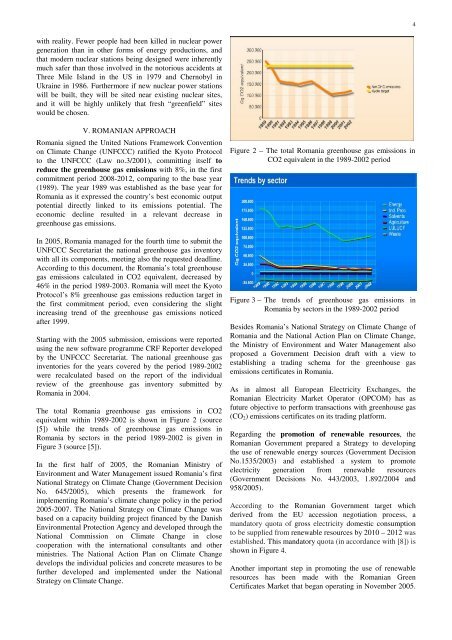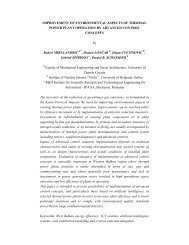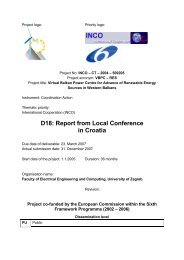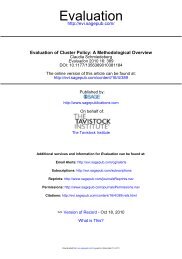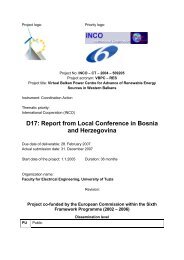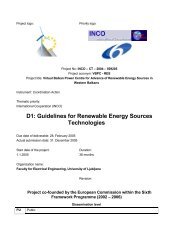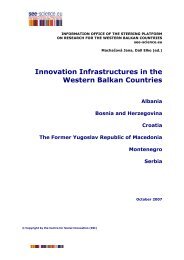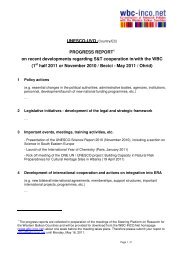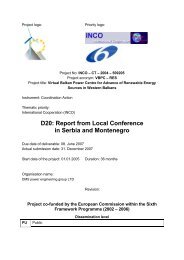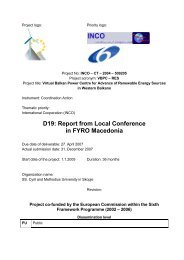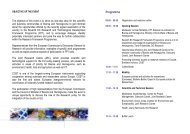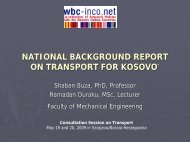Prva stran - WBC-INCO Net
Prva stran - WBC-INCO Net
Prva stran - WBC-INCO Net
You also want an ePaper? Increase the reach of your titles
YUMPU automatically turns print PDFs into web optimized ePapers that Google loves.
with reality. Fewer people had been killed in nuclear power<br />
generation than in other forms of energy productions, and<br />
that modern nuclear stations being designed were inherently<br />
much safer than those involved in the notorious accidents at<br />
Three Mile Island in the US in 1979 and Chernobyl in<br />
Ukraine in 1986. Furthermore if new nuclear power stations<br />
will be built, they will be sited near existing nuclear sites,<br />
and it will be highly unlikely that fresh “greenfield” sites<br />
would be chosen.<br />
V. ROMANIAN APPROACH<br />
Romania signed the United Nations Framework Convention<br />
on Climate Change (UNFCCC) ratified the Kyoto Protocol<br />
to the UNFCCC (Law no.3/2001), committing itself to<br />
reduce the greenhouse gas emissions with 8%, in the first<br />
commitment period 2008-2012, comparing to the base year<br />
(1989). The year 1989 was established as the base year for<br />
Romania as it expressed the country’s best economic output<br />
potential directly linked to its emissions potential. The<br />
economic decline resulted in a relevant decrease in<br />
greenhouse gas emissions.<br />
In 2005, Romania managed for the fourth time to submit the<br />
UNFCCC Secretariat the national greenhouse gas inventory<br />
with all its components, meeting also the requested deadline.<br />
According to this document, the Romania’s total greenhouse<br />
gas emissions calculated in CO2 equivalent, decreased by<br />
46% in the period 1989-2003. Romania will meet the Kyoto<br />
Protocol’s 8% greenhouse gas emissions reduction target in<br />
the first commitment period, even considering the slight<br />
increasing trend of the greenhouse gas emissions noticed<br />
after 1999.<br />
Starting with the 2005 submission, emissions were reported<br />
using the new software programme CRF Reporter developed<br />
by the UNFCCC Secretariat. The national greenhouse gas<br />
inventories for the years covered by the period 1989-2002<br />
were recalculated based on the report of the individual<br />
review of the greenhouse gas inventory submitted by<br />
Romania in 2004.<br />
The total Romania greenhouse gas emissions in CO2<br />
equivalent within 1989-2002 is shown in Figure 2 (source<br />
[5]) while the trends of greenhouse gas emissions in<br />
Romania by sectors in the period 1989-2002 is given in<br />
Figure 3 (source [5]).<br />
In the first half of 2005, the Romanian Ministry of<br />
Environment and Water Management issued Romania’s first<br />
National Strategy on Climate Change (Government Decision<br />
No. 645/2005), which presents the framework for<br />
implementing Romania’s climate change policy in the period<br />
2005-2007. The National Strategy on Climate Change was<br />
based on a capacity building project financed by the Danish<br />
Environmental Protection Agency and developed through the<br />
National Commission on Climate Change in close<br />
cooperation with the international consultants and other<br />
ministries. The National Action Plan on Climate Change<br />
develops the individual policies and concrete measures to be<br />
further developed and implemented under the National<br />
Strategy on Climate Change.<br />
Figure 2 – The total Romania greenhouse gas emissions in<br />
CO2 equivalent in the 1989-2002 period<br />
Figure 3 – The trends of greenhouse gas emissions in<br />
Romania by sectors in the 1989-2002 period<br />
Besides Romania’s National Strategy on Climate Change of<br />
Romania and the National Action Plan on Climate Change,<br />
the Ministry of Environment and Water Management also<br />
proposed a Government Decision draft with a view to<br />
establishing a trading schema for the greenhouse gas<br />
emissions certificates in Romania.<br />
As in almost all European Electricity Exchanges, the<br />
Romanian Electricity Market Operator (OPCOM) has as<br />
future objective to perform transactions with greenhouse gas<br />
(CO2) emissions certificates on its trading platform.<br />
Regarding the promotion of renewable resources, the<br />
Romanian Government prepared a Strategy to developing<br />
the use of renewable energy sources (Government Decision<br />
No.1535/2003) and established a system to promote<br />
electricity generation from renewable resources<br />
(Government Decisions No. 443/2003, 1.892/2004 and<br />
958/2005).<br />
According to the Romanian Government target which<br />
derived from the EU accession negotiation process, a<br />
mandatory quota of gross electricity domestic consumption<br />
to be supplied from renewable resources by 2010 – 2012 was<br />
established. This mandatory quota (in accordance with [8]) is<br />
shown in Figure 4.<br />
Another important step in promoting the use of renewable<br />
resources has been made with the Romanian Green<br />
Certificates Market that began operating in November 2005.<br />
4


